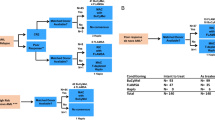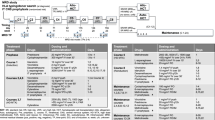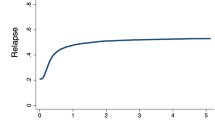Abstract
The objective of the AML HD93 treatment trial was to evaluate the outcome in young adults with acute myeloid leukemia (AML) after postremission therapy was stratified according to cytogenetically defined risk. The rationales for the study design were based (i) on previous favorable results with high-dose cytarabine in AML with t(8;21), inv/t(16q22) and in AML with normal karyotype, and ii) on encouraging results obtained in several phase II trials using autologous stem cell transplantation (SCT). Between July 1993 and January 1998, 223 eligible patients, 16–60 years of age with newly diagnosed AML other than French–American–British type M3/M3v, were entered into the trial. Risk groups were defined as follows: low risk: t(8;21) or inv/t(16q22); intermediate risk: normal karyotype; high risk: all other chromosomal abnormalities. Following intensive double induction therapy with idarubicin, cytarabine and etoposide, all patients in complete remission (CR) received a first consolidation therapy with high-dose cytarabine and mitoxantrone (HAM). A second consolidation therapy was stratified according to the risk group: low risk: HAM; intermediate risk: related allogeneic SCT or sequential HAM; high risk: related allogeneic or autologous SCT. Double induction therapy resulted in a high CR rate of 74.5%, and 90% of the responding patients were eligible for consolidation therapy. Survival for all 223 trial entrants was 40%, and for the 166 patients who entered CR, disease-free (DFS) and overall survival were 40 and 51% after 5 years, respectively. Within the low-, intermediate- and high-risk groups, DFS and survival after 5 years were 62.5 and 87, 40 and 49 and 17 and 26% respectively, without advantage for allogeneic transplantation in the intermediate- and high-risk groups. Postremission therapy-related mortality was 0, 7 and 14%, respectively. This study demonstrates the feasibility of cytogenetically defined risk-adapted consolidation therapy. The overall trial results are at least equivalent to those of published trials supporting the risk-adapted treatment strategy.
This is a preview of subscription content, access via your institution
Access options
Subscribe to this journal
Receive 12 print issues and online access
$259.00 per year
only $21.58 per issue
Buy this article
- Purchase on Springer Link
- Instant access to full article PDF
Prices may be subject to local taxes which are calculated during checkout






Similar content being viewed by others
References
Arthur DC, Berger R, Golomb HM, Swansbury GJ, Reeves BR, Alimena G et al. The clinical significance of karyotype in acute myelogenous leukemia. Cancer Genet Cytogenet 1989; 40: 203–216.
Bloomfield CD, Lawrence D, Byrd JC, Carroll A, Pettenati MJ, Tantravahi R et al. Frequency of prolonged remission duration after high-dose cytarabine intensification in acute myeloid leukemia varies by cytogenetic subtype. Cancer Res 1998; 58: 4173–4179.
Grimwade D, Walker H, Oliver F, Wheatley K, Harrison C, Harrison G et al. The importance of diagnostic cytogenetics on outcome in AML: analysis of 1,612 patients entered into the MRC AML 10 trial. The Medical Research Council Adult and Children's Leukaemia Working Parties. Blood 1998; 92: 2322–2333.
Mrózek K, Heinonen K, Bloomfield CD . Clinical importance of cytogenetics in acute myeloid leukaemia. Baillieres Best Pract Res Clin Haematol 2001; 14: 19–47.
Slovak ML, Kopecky KJ, Cassileth PA, Harrington DH, Theil KS, Mohamed A et al. Karyotypic analysis predicts outcome of preremission and postremission therapy in adult acute myeloid leukemia: a Southwest Oncology Group/Eastern Cooperative Oncology Group Study. Blood 2000; 96: 4075–4083.
Mayer RJ, Davis RB, Schiffer CA, Berg DT, Powell BL, Schulman P et al. Intensive post remission chemotherapy in adults with acute myeloid leukemia. N Engl J Med 1994; 331: 896–903.
Weick JK, Kopecky KJ, Applebaum FR, Head DR, Kingsbury LL, Balcerzak SP et al. A randomized investigation of high-dose versus standard-dose cytosine arabinoside with daunorubicin in patients with previously untreated acute myeloid leukemia: A Southwest Oncology Group Study. Blood 1996; 88: 2841–2851.
Gorin NC . Autologous stem cell transplantation in acute myelocytic leukemia. Blood 1998; 92: 1073–1090.
Cassileth PA, Harrington DP, Appelbaum FR, Lazarus HM, Rowe JM, Paietta E et al. Chemotherapy compared with autologous or allogeneic bone marrow transplantation in the management of acute myeloid leukemia in first remission. N Engl J Med 1998; 339: 1649–1656.
Burnett AK, Goldstone AH, Stevens RM, Hann IM, Rees JK, Gray RG et al. Randomised comparison of addition of autologous bone-marrow transplantation to intensive chemotherapy for acute myeloid leukaemia in first remission: results of MRC AML 10 trial. UK Medical Research Council Adult and Children's Leukaemia Working Parties. Lancet 1998; 351: 700–708.
Harousseau JL, Cahn JY, Pignon B, Witz F, Milpied N, Delain M et al. Comparison of autologous bone marrow transplantation and intensive chemotherapy as postremission therapy in adult acute myeloid leukemia. The Groupe Ouest Est Leucemies Aigues Myeloblastiques (GOELAM). Blood 1997; 90: 2978–2986.
Zittoun RA, Mandelli F, Willemze R, de Witte T, Labar B, Resegotti L et al. Autologous or allogeneic bone marrow transplantation compared with intensive chemotherapy in acute myelogenous leukemia. European Organization for Research and Treatment of Cancer (EORTC) and the Gruppo Italiano Malattie Ematologiche Maligne dell'Adulto (GIMEMA) Leukemia Cooperative Groups. N Engl J Med 1995; 332: 217–223.
Bloomfield CD . Prognostic factors for selecting curative therapy for adult acute myeloid leukemia. Leukemia 1992; 4 (Suppl 6): 65–67.
Bennett JM, Catovsky D, Daniel MT, Flandrin G, Galton DA, Gralnick HR et al. Proposals for the classification of the acute leukemias. Br J Haematol 1976; 33: 451.
Bennett JM, Catovsky D, Daniel MT, Flandrin G, Galton DA, Gralnick HR et al. Proposed revised criteria for the classification of acute myeloid leukemia. Ann Intern Med 1985; 103: 626.
Mitelman F (ed) ISCN (1995). An International System for Human Cytogenetic Nomenclature. Basel, Switzerland: Karger, 1995.
Fischer K, Scholl C, Sàlat J, Fröhling S, Schlenk R, Bentz M et al. Design and validation of DNA probe sets for a comprehensive interphase cytogenetic analysis of acute myeloid leukemia. Blood 1996; 88: 3962–3971.
Fröhling S, Skelin S, Liebisch C, Scholl C, Schlenk RF, Döhner H et al. Comparison of cytogenetic and molecular cytogenetic detection of chromosome abnormalities in 240 consecutive adult patients with acute myeloid leukemia. J Clin Oncol 2002; 20: 2480–2485.
Hiddemann W, Büchner T, Essink M, Koch O, Stenzinger W, van de Loo J . High-dose cytosine arabinoside and mitoxantrone: preliminary results of a pilot study with sequential application (S-HAM) indicating a high antileukemic activity in refractory acute leukemias. Onkologie 1988; 11: 10–12.
Schlenk RF, Döhner H, Pförsich M, Benner A, Fischer K, Hartmann F et al. Successful collection of peripheral blood progenitor cells in patients with acute myeloid leukaemia following early consolidation therapy with granulocyte colony-stimulating factor-supported high-dose cytarabine and mitoxantrone. Br J Haematol 1997; 99: 386–393.
Martin H, Bruecher J, Claude R, Hoelzer D . Cumulative chemotherapy increases mafosfamide toxicity for normal progenitor cells in AML patients: rationale for cryopreserving adapted-dose purged marrow early in first complete remission. Bone Marrow Transplant 1993; 12: 495–499.
Cheson BD, Cassileth PA, Head DR, Schiffer CA, Bennett JM, Bloomfield CD et al. Report of the National Cancer Institute-sponsored workshop on definitions of diagnosis and response in acute myeloid leukemia. J Clin Oncol 1990; 8: 813–819.
Korn EL . Censoring distributions as a measure of follow-up in survival analysis. Stat Med 1986; 5: 255–260.
Kaplan EL, Meier P . Non-parametric estimation form incomplete observation. J Am Stat Assoc 1958; 47: 457–481.
Therneau TM, Grambsch PM . Modeling Survival Data: Extending the Cox Model. New York: Springer-Verlag, 2000.
Mantel N, Haenszel W . Statistical aspects of the analysis of data from retrospective studies of disease. J Nat Cancer Inst 1959; 22: 719–748.
Cox DR . Regression models and life tables. J R Stat Soc Ser B 1972; 34: 187–220.
Harrell FE . Regression Modeling Strategies: With Applications to Linear Models, Logistic Regression, and Survival Analysis. New York: Springer-Verlag, 2001.
Lausen B, Schumacher M . Maximally selected rank statistics. Biometrics 1992; 48: 73–85.
Wheatley K, Burnett AK, Goldstone AH, Gray RG, Hann IM, Harrison CJ et al. A simple, robust, validated and highly predictive index for the determination of risk-directed therapy in acute myeloid leukaemia derived from the MRC AML 10 trial. United Kingdom Medical Research Council's Adult and Childhood Leukaemia Working Parties. Br J Haematol 1999; 107: 69–79.
Kern W, Aul C, Maschmeyer G, Schonrock-Nabulsi R, Ludwig WD, Bartholomaus A et al. Superiority of high-dose over intermediate-dose cytosine arabinoside in the treatment of patients with high-risk acute myeloid leukemia: results of an age-adjusted prospective randomized comparison. Leukemia 1998; 12: 1049–1055.
Biggs JC, Horowitz MM, Gale RP, Ash RC, Atkinson K, Helbig W et al. Bone marrow transplants may cure patients with acute leukemia never achieving remission with chemotherapy. Blood 1992; 80: 1090–1093.
Forman SJ, Schmidt GM, Nademanee AP, Amylon MD, Chao NJ, Fahey JL et al. Allogeneic bone marrow transplantation as therapy for primary induction failure for patients with acute leukemia. J Clin Oncol 1991; 9: 1570–1574.
Platzbecker U, Thiede C, Freiberg-Richter J, Rollig C, Helwig A, Schakel U et al. Early allogeneic blood stem cell transplantation after modified conditioning therapy during marrow aplasia: stable remission in high-risk acute myeloid leukemia. Bone Marrow Transplant 2001; 27: 543–546.
Ferrant A, Labopin M, Frassoni F, Prentice HG, Cahn JY, Blaise D et al. Karyotype in acute myeloblastic leukemia: prognostic significance for bone marrow transplantation in first remission: a European Group for Blood and Marrow Transplantation study. Acute Leukemia Working Party of the European Group for Blood and Marrow Transplantation (EBMT). Blood 1997; 90: 2931–2938.
Nguyen S, Leblanc T, Fenaux P, Witz F, Blaise D, Pigneux A et al. A white blood cell index as the main prognostic factor in t(8;21) acute myeloid leukemia (AML): a survey of 161 cases from the French AML Intergroup. Blood 2002; 99: 3517–3523.
Billstrom R, Johansson B, Fioretos T, Garwicz S, Malm C, Zettervall O et al. Poor survival in t(8;21) (q22;q22)-associated acute myeloid leukaemia with leukocytosis. Eur J Haematol 1997; 59: 47–52.
Martin G, Barragan E, Bolufer P, Chillon C, Garcia-Sanz R, Gomez T et al. Relevance of presenting white blood cell count and kinetics of molecular remission in the prognosis of acute myeloid leukemia with CBFbeta/MYH11 rearrangement. Haematologica 2000; 85: 699–703.
O'Brien S, Kantarjian HM, Keating M, Gagnon G, Cork A, Trujillo J et al. Association of granulocytosis with poor prognosis in patients with acute myelogenous leukemia and translocation of chromosomes 8 and 21. J Clin Oncol 1989; 7: 1081–1086.
Kiyoi H, Naoe T, Nakano Y, Yokota S, Minami S, Miyawaki S et al. Prognostic implication of FLT3 and N-RAS gene mutations in acute myeloid leukemia. Blood 1999; 93: 3074–3080.
Fröhling S, Schlenk RF, Breitruck J, Benner A, Kreitmeier S, Tobis K et al. Prognostic significance of activating FLT3 mutations in younger adults (16 to 60 years) with acute myeloid leukemia and normal cytogenetics: a study of the AML Study Group Ulm (AMLSG ULM). Blood 2002; 100: 4372–4380.
Thiede C, Steudel C, Mohr B, Schaich M, Schakel U, Platzbecker U et al. Analysis of FLT3-activating mutations in 979 patients with acute myelogenous leukemia: association with FAB subtypes and identification of subgroups with poor prognosis. Blood 2002; 99: 4326–4335.
Döhner K, Tobis K, Ulrich R, Fröhling S, Benner A, Schlenk RF et al. Prognostic significance of partial tandem duplications of the MLL gene in adult patients 16 to 60 years old with acute myeloid leukemia and normal cytogenetics: a study of the AML SG ULM. J Clin Oncol 2002; 20: 3254–3261.
Caligiuri MA, Strout MP, Lawrence D, Arthur DC, Baer MR, Yu F et al. Rearrangement of ALL1 (MLL) in acute myeloid leukemia with normal cytogenetics. Cancer Res 1998; 58: 55–59.
Preudhomme C, Sagot C, Boissel N, Cayuela JM, Tigaud I, de Botton S et al. Favorable prognostic significance of CEBPA mutations in patients with de novo acute myeloid leukemia: a study from the Acute Leukemia French Association (ALFA). Blood 2002; 100: 2717–2723.
Körbling M, Fliedner TM, Holle R, Magrin S, Baumann M, Holdermann E et al. Autologous blood stem cell (ABSCT) versus purged bone marrow transplantation (pABMT) in standard risk AML: influence of source and cell composition of the autograft on hemopoietic reconstitution and disease-free survival. Bone Marrow Transplant 1991; 7: 343–349.
Bunjes D, Buchmann I, Duncker C, Seitz U, Kotzerke J, Wiesneth M et al. Rhenium 188-labeled anti-CD66 (a, b, c, e) monoclonal antibody to intensify the conditioning regimen prior to stem cell transplantation for patients with high-risk acute myeloid leukemia or myelodysplastic syndrome: results of a phase I–II study. Blood 2001; 98: 565–572.
Matthews DC, Appelbaum FR, Eary JF, Fisher DR, Durack LD, Hui TE et al. Phase I study of (131)I-anti-CD45 antibody plus cyclophosphamide and total body irradiation for advanced acute leukemia and myelodysplastic syndrome. Blood 1999; 94: 1237–1247.
Büchner T, Hiddemann W, Wörmann B, Loffler H, Gassmann W, Haferlach T et al. Double induction strategy for acute myeloid leukemia: the effect of high-dose cytarabine with mitoxantrone instead of standard-dose cytarabine with daunorubicin and 6-thioguanine: a randomized trial by the German AML Cooperative Group. Blood 1999; 93: 4116–4124.
Büchner T, Döhner H, Ehninger G, Ganser A, Hasford J . Up-front randomization and common standard arm: a proposal for comparing AML treatment strategies between different studies. Leukemia Res 2002; 26: 1073–1075.
Acknowledgements
We gratefully acknowledge Brigitte Schreiter for technical assistance.
Author information
Authors and Affiliations
Consortia
Rights and permissions
About this article
Cite this article
Schlenk, R., Benner, A., Hartmann, F. et al. Risk-adapted postremission therapy in acute myeloid leukemia: results of the german multicenter AML HD93 treatment trial. Leukemia 17, 1521–1528 (2003). https://doi.org/10.1038/sj.leu.2403009
Published:
Issue Date:
DOI: https://doi.org/10.1038/sj.leu.2403009
Keywords
This article is cited by
-
Comparison of efficacy between homoharringtonine, aclarubicin, cytarabine (HAA) and idarubicin, cytarabine (IA) regimens as induction therapy in patients with de novo core binding factor acute myeloid leukemia
Annals of Hematology (2023)
-
Improved outcome in children compared to adolescents and young adults after allogeneic hematopoietic stem cell transplant for acute myeloid leukemia: a retrospective study from the Francophone Society of Bone Marrow Transplantation and Cell Therapy (SFGM-TC)
Journal of Cancer Research and Clinical Oncology (2022)
-
The evolving concept of indications for allogeneic hematopoietic cell transplantation during first complete remission of acute myeloid leukemia
Bone Marrow Transplantation (2021)
-
Core binding factor acute myelogenous leukemia-2021 treatment algorithm
Blood Cancer Journal (2021)
-
Cladribine in the remission induction of adult acute myeloid leukemia: where do we stand?
Annals of Hematology (2019)



